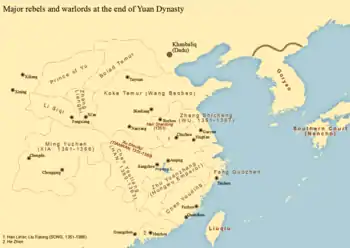Great Zhou 大周 | |||||||||
|---|---|---|---|---|---|---|---|---|---|
| 1354–1357 | |||||||||
| Status | Kingdom | ||||||||
| Capital | Gaoyou Suzhou (1356–1357) | ||||||||
| Common languages | Chinese | ||||||||
| Religion | Buddhism, Taoism, Confucianism, Chinese folk religion | ||||||||
| Government | Monarchy | ||||||||
| King | |||||||||
• 1354–1357 | Zhang Shicheng | ||||||||
| History | |||||||||
• Established | 1354 | ||||||||
• Disestablished | 1357 | ||||||||
| Currency | Chinese coin, Chinese cash | ||||||||
| |||||||||
| Today part of | China | ||||||||
Zhou, officially the Great Zhou (Chinese: 大周; pinyin: Dà Zhōu), was one of the short-lived rebel states that existed in China during the Red Turban Rebellion in the final phase of the Yuan dynasty. It was founded in 1354 in Jiangxi by the local rebel leader, Zhang Shicheng.[1] At first, it included a small area around Gaoyou in central Jiangsu. In 1355–1356, it extended its power south from the Yangtze River to northern Zhejiang. Zhang moved south to Suzhou in 1356 and submitted to Yuan rule the following year, relinquishing his royal title.
References
Citations
Sources
This article is issued from Wikipedia. The text is licensed under Creative Commons - Attribution - Sharealike. Additional terms may apply for the media files.
